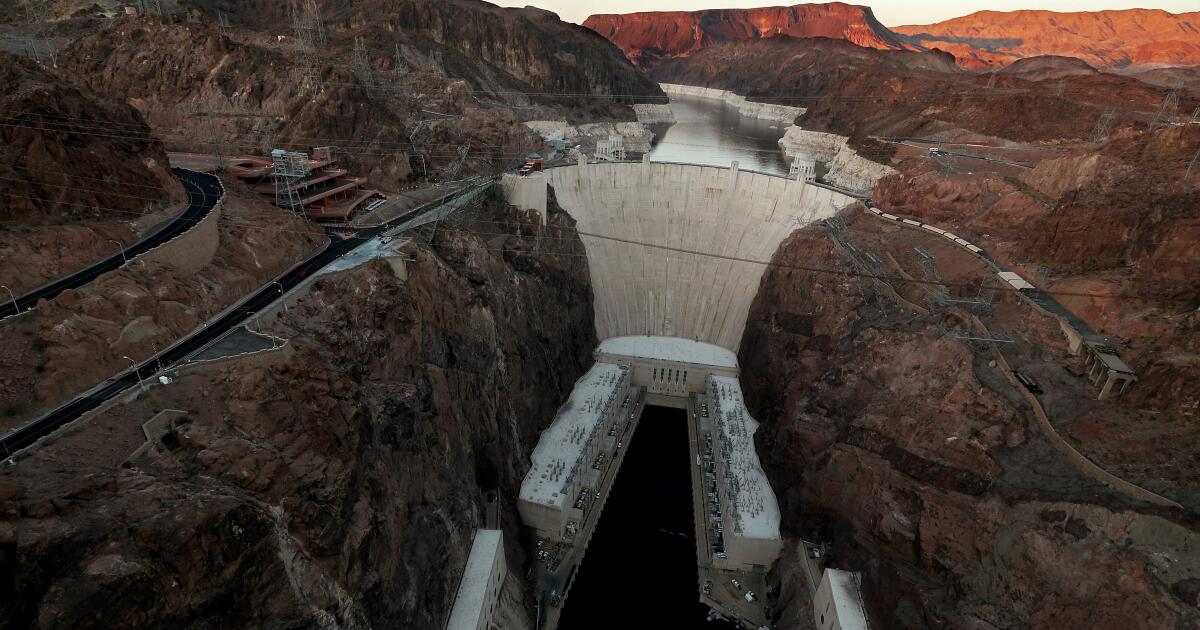Biden administration outlines options for addressing Colorado River water shortages
The Biden administration has announced a range of options for new rules to address chronic water shortages and low reservoir levels on the Colorado River, a vital water source for seven Western states that has dwindled during more than two decades of drought compounded by climate change.
The Interior Department released four alternatives for new long-term rules aimed at dealing with potential shortages after 2026, when the current operating rules expire. The announcement of the proposed alternatives represents one of the Biden administration’s final steps to outline potential paths toward reaching a consensus among California and the six other states, as well as the region’s 30 Native tribes.
“We’re putting forth alternatives that establish a robust and fair framework for a basin-wide agreement,” said Laura Daniel-Davis, acting deputy Interior secretary. “Now really is the time for the basin states and tribes to redouble their work toward a consensus alternative.”
The action advances a federal review process that President-elect Donald Trump’s administration will inherit. But while the change in administration brings a dose of uncertainty, the biggest challenge for the region currently appears to be the stark divisions among the seven states that have emerged in negotiations over the last year.
There have been persistent disagreements about how triggers for water cutbacks should be determined and how those reductions should be apportioned. The disputes have pitted the three states in the river’s lower basin — California, Arizona and Nevada — against the four upper-basin states — Colorado, Utah, Wyoming and New Mexico.
“There certainly are extremely difficult choices and tradeoffs to be made, but we believe that there are ample opportunities to create a fair path to solutions that work for the entire basin,” federal Bureau of Reclamation Commissioner Camille Calimlim Touton told reporters in a conference call.
The Colorado River provides water for cities from Denver to San Diego, tribal communities and farmlands across seven states and northern Mexico. The river has long been overallocated, and its reservoirs have declined dramatically since 2000.
The average flow of the river has shrunk about 20% since 2000, and scientists have estimated that roughly half that decline has been caused by global warming driven by the burning of fossil fuels and rising levels of greenhouse gases. The decline in flow is projected to continue to worsen as temperatures climb.
In recent years, states that depend on the river have adopted a series of incremental water-saving plans in an effort to prevent the Colorado’s reservoirs from falling to critically low levels.
The Interior Department in 2023 began the process of developing long-term operating guidelines to replace rules that expire in December 2026. The agency says an operating plan must be in effect by August 2026.
In its announcement of the alternatives, the Interior Department said the overarching goals include defining water allocations, guiding management of the river and “guarding against the need for the kind of short-term fix” that state and federal officials negotiated to temporarily reduce water use and boost reservoir levels from 2024 through 2026. The Biden administration has recently been funding programs that pay farmers to temporarily reduce water use in exchange for payments.
The Bureau of Reclamation, which manages dams on the river, said the four alternatives include: one that focuses on federal authorities absent new agreements; a second hybrid approach based on federal authorities; a third “cooperative conservation” alternative that would include “incentivizing” water conservation and developing flexible management strategies; and a fourth that would be a hybrid of proposals submitted by the states and tribes.
Also included was a “no action” alternative, as required under federal environmental law.
California, which uses more Colorado River water than any other state, responded with caution and cited the 1922 Colorado River Compact, which allocated the river’s water among the states and established the legal framework that continues to govern its today.
“Federal law requires the Colorado River Basin’s reservoirs be managed in accordance with the Colorado River Compact — the most significant component of which is mandatory deliveries of water from the Upper Basin to the Lower Basin and Mexico,” said J.B. Hamby, California’s Colorado River commissioner. “In order to be valid, any alternative considered must meet this requirement unless the states agree to a compromise otherwise.”
The federal government announced the alternatives shortly before Touton was scheduled to meet with state and tribal leaders for the latest in a series of working group discussions.
Water management officials and representatives of states and tribes will also gather in Las Vegas from Dec. 4-6 for an annual conference of Colorado River water users, an event that often features negotiating sessions in addition to speeches outlining proposals for reducing demands on the river.
White House national climate advisor Ali Zaidi noted that in 2023 the seven states reached a consensus deal to make substantial short-term reductions in water use.
“We can either remain stuck at an impasse, or we can secure a future for future generations that promises the stability and sustainability of one of our greatest natural resources,” Zaidi said.
The options the federal government has outlined, he said, “provide essentially a platform to reach a consensus path.”

